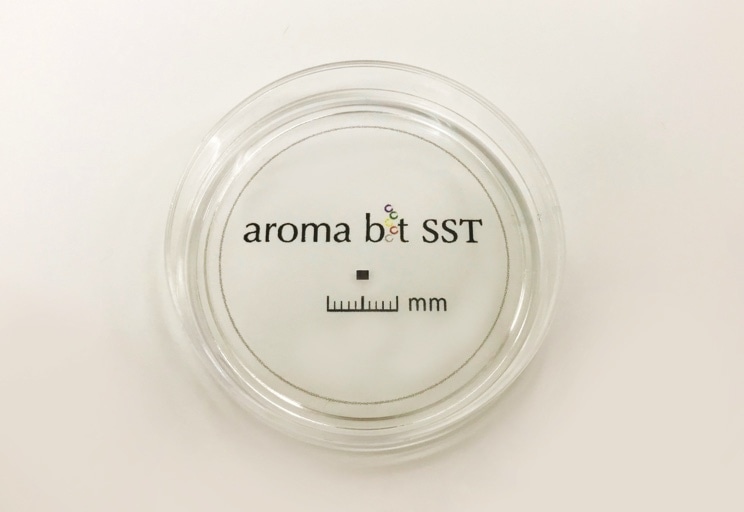Jul 23 2019
Aroma Bit has set up a new subsidiary to build the next-generation smell sensor based on silicon CMOS sensor substrate that are high resolution, ultra-compact, and economical.
 1 mm squared die of silicon CMOS-based smell sensor, with dog nose equivalent ~1,200 sensor pixels (Photo credit: Business Wire)
1 mm squared die of silicon CMOS-based smell sensor, with dog nose equivalent ~1,200 sensor pixels (Photo credit: Business Wire)
The technology is realized by applying Aroma Bit designed smell sensor receptor membrane technology to ultra-sensitive silicon CMOS-based ion imaging sensor technology created by Professor Kazuaki Sawada at Toyohashi University of Technology and associated companies.
Realizing smartphone embeddable smell sensor with dog nose equivalent ultra-high resolution smell sensor on only 1 mm2 silicon die size
Aroma Bit has created and is presently selling a compact smell sensor that uses Quartz Crystal Microbalance (QCM) type sensor substrate, which exhibits ultra-high sensitivity in the sensor market. However, additional size reduction and cost reduction to match high-volume application market, such as smartphone was difficult with conventional QCM-type smell sensor.
With the recently created silicon CMOS-type smell sensor, high smell resolution, ultra-compact, and low cost can be attained, to be embedded to systems such as IoT devices or smartphones. For example, it is anticipated that resolution equivalent to dog nose’s resolution (approximately 1,200 receptors) within 1 mm die size can be realized using the new variety of sensor substrate.
With the new incorporation of sensor substrate technology, Aroma Bit currently holds two kinds of sensor substrate technology line up: (1) conventional and yet ultra-high sensitivity QCM-type sensor substrate technology, and (2) ultra-high resolution, ultra-compact, economical silicon CMOS-type sensor substrate technology.
Combined, very competitive sensor technology portfolio is attained in two crucial performances for smell sensor, specifically, smell resolution and sensor sensitivity. Consequently, the incorporation of the new sensor is anticipated to further improve Aroma Bit’s technology competitive advantage against its competitors in the compact smell sensor market arena.
Aroma Bit is also currently speeding up its development of a digital smell database or smell big-data based on its hardware competitive edge. With the sensor hardware and smell database together, Aroma Bit is dedicated to retaining its top-position in the growing digital olfactory market, thus keeping with the company’s vision “to realize a better world by visualizing the world of smell/aroma through odor imaging technology.”
New subsidiary certified as the first Toyohashi University of Technology University- Launched Venture Company
Aroma Bit Silicon Sensor Technology, Inc. is certified as the first Toyohashi University of Technology certified University-Launched Venture Company.
While University-Launched Venture companies are on the rise in Japan, there are only a few successful cases leading to industrialization, because of factors such as lack of intellectual property conflict among large companies interest, skill set discrepancy on researcher as entrepreneurs, among others.
In this specific industry-academia partnership case, the chance to market technology is anticipated to increase by assigning the venture company a role to boost business development of the technology created mutually with the university.
Background
Aroma Bit did well in creating next-generation smell sensor based on silicon CMOS sensor substrate that is high resolution and ultra-compact by applying Aroma Bit developed smell sensor receptor membrane technology to ultra-sensitive silicon CMOS-based ion imaging sensor technology designed by Professor Kazuaki Sawada at Toyohashi University of Technology.
In 2017, Toyohashi Technology of University, Toyohashi Sensor Kyogikai Corporation, Hamamatsu Photonics K.K., Toho Technology Corporation, Nippon Chemi-con Corporation, and Aroma Bit together set up the private CMOS Odor Sensor Consortium (COSCo Consortium). In 2018, the COSCo consortium launched working prototypes, for example, Kaori-Camera (Aroma Camera) and i-sniffer.
Keen on aggregating the accomplishment from COSCo consortium and further speeding up development and industrialization, Aroma Bit Silicon Sensor Technology, Inc. (Hereafter, “ABSST”) is established as Aroma Bit’s subsidiary.
ABSST is dedicated to engineer the silicon CMOS-type next-generation smell sensor that is ultra-compact with ultra-high resolution and low-cost and can be embedded into smartphones and IoT Devices.